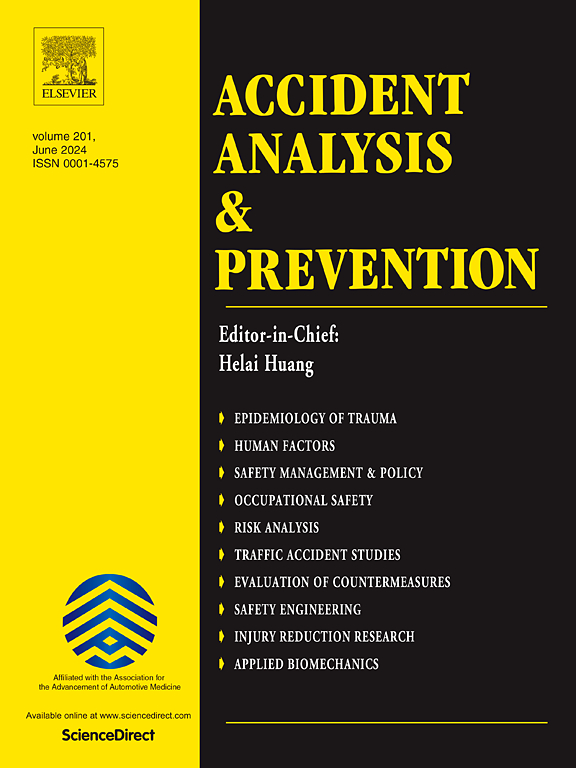基于轨迹的交叉口冲突局部特征判定指标:微空间分析
IF 6.2
1区 工程技术
Q1 ERGONOMICS
引用次数: 0
摘要
真实世界的行为数据是评估特定道路基础设施环境下道路安全的最可靠参考。然而,快速、便携地收集和实施道路安全研究仍然具有挑战性,面临数据保护问题和建立自有电源的持续跟踪机制的复杂性。为了解决这些限制,移动观测箱(MOB)提供了一个灵活的数据收集,用于随后的视频分析。物体检测和跟踪允许导出运动轨迹,进而允许导出道路安全相关行为的定量指标,即完善的替代安全措施(SSMs),如后侵犯时间(PET),最接近时间(TCA)和碰撞时间(TTC)以及一些指标,如两个互动伙伴的最大速度,它们彼此接近的角度以及它们在相互作用中某一点的最小距离。为了促进潜在的MOB应用,本研究利用维也纳繁忙十字路口超过51小时的自然视频数据,通过(i)采用关键冲突发生可能性的随机参数二值建模和(ii)高斯广义加性空间建模来推进道路安全研究,以确定仅在关键冲突上影响冲突角度绝对值的关键因素。在研究的十字路口内,确定了具体的速度和加速度效应,以及各自的异质性均值,以及不同道路使用者类型的显著分类效应。与处于领先(首先被发现)和跟随(其次被发现)角色的汽车相比,所有道路使用者类型最终都不太可能卷入安全关键冲突,但处于领先角色的骑自行车者除外。在微空间分析中,发现仅第二道路使用者的运动学参数(速度、最大加速度和最大减速)、相互作用的持续时间以及与主要道路使用者位置相关的交叉口特定局部效应都会影响转换后的临界冲突角绝对值。本文章由计算机程序翻译,如有差异,请以英文原文为准。
Trajectory-based indicators to determine the local character of intersection conflicts: A micro-spatial analysis
Real world behaviour data is the most reliable reference to assess road safety in a specific road infrastructure context. However, its collection and implementation for road safety research in a rapid and portable manner is still challenging, facing data protection issues and the complexities to set up constant tracking mechanisms with their own power supply. To tackle these limitations, the Mobility Observation Box (MOB) provides a flexible data collection, to be used in subsequent video analysis. Object detection and tracking allow for the derivation of movement trajectories, which in turn allow to derive quantitative indicators of road safety relevant behaviour, namely well-established Surrogate Safety Measures (SSMs), such as Post-Encroachment-Time (PET), Time-to-Closest-Approach (TCA) and Time-to-Collision-(TTC) alongside a number of indicators like maximum speed of two interaction partners, the angle they approach each other in and the minimum distance they had at one point in their interaction. To facilitate potential MOB uses, this study leverages over 51 h of naturalistic video data at a busy Vienna intersection to advance road safety research by (i) employing random parameters binary modelling of the likelihood of critical conflict occurrence and (ii) Gaussian generalized additive spatial modelling to identify key factors influencing the absolute values of conflict angles on critical conflicts only. Within the examined intersection, specific speed and acceleration effects were determined, together with the respective heterogeneity-in-means, as well as significant categorical effects of different road user types. All road user types were ultimately less likely to be involved in safety–critical conflicts compared to cars in both leading (firstly detected) and following (secondly detected) roles, with the exception of cyclists in the leading role. Within the micro-spatial analysis, the kinematic parameters of the second road user only (speed, max acceleration and max deceleration), the duration of the interaction as well as intersection-specific local effects related to the position of the leading road user were all found to influence the transformed absolute value of the angles of critical conflicts.
求助全文
通过发布文献求助,成功后即可免费获取论文全文。
去求助
来源期刊

Accident; analysis and prevention
Multiple-
CiteScore
11.90
自引率
16.90%
发文量
264
审稿时长
48 days
期刊介绍:
Accident Analysis & Prevention provides wide coverage of the general areas relating to accidental injury and damage, including the pre-injury and immediate post-injury phases. Published papers deal with medical, legal, economic, educational, behavioral, theoretical or empirical aspects of transportation accidents, as well as with accidents at other sites. Selected topics within the scope of the Journal may include: studies of human, environmental and vehicular factors influencing the occurrence, type and severity of accidents and injury; the design, implementation and evaluation of countermeasures; biomechanics of impact and human tolerance limits to injury; modelling and statistical analysis of accident data; policy, planning and decision-making in safety.
 求助内容:
求助内容: 应助结果提醒方式:
应助结果提醒方式:


